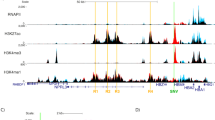Abstract
Site-1 protease (S1P) is a subtilisin-related enzyme that cleaves sterol regulatory element-binding proteins (SREBPs) in the lumen of endoplasmic reticulum, thereby initiating the release of transcriptionally active NH2-terminal fragments of SREBPs from membranes. In the experiments reported here, we localized the human S1P gene to chromosome 16q24 by fluorescent in situ hybridization and radiation-hybrid mapping, and determined its genomic structure. This gene is more than 60 kb long and contains 23 exons and 22 introns. Its transcription-initiation site within exon 1 is separate from the initiation codon in exon 2. Analysis of the exon/intron structure revealed that the S1P gene consists of a mosaic of functional units: exon 1 encodes the 5′ non-translated region; exon 2 encodes the NH2-terminal signal sequence; and exons 2 and 3 encode the pro-peptide sequence that is released when S1P is self-activated by intramolecular cleavage. Exons 5–10 encode the subtilisin-homology domain that is critical for catalytic activity, and exon 23 encodes the transmembrane region. Analysis of the putative promoter region revealed a highly G/C-rich region containing a binding site for ADD1/SREBP-1, as well as Sp1 and AP2 sites. Therefore, expression of the S1P gene may be under the control of SREBP-1, a key regulator of the expression of genes essential for intracellular lipid metabolism. Our data establish a basis for investigations to detect molecular variants in this gene that may alter levels of plasma lipoproteins and/or otherwise disrupt intracellular lipid metabolism.
Similar content being viewed by others
Article PDF
Author information
Authors and Affiliations
Additional information
Received: December 27, 1999 / Accepted: March 21, 2000
Rights and permissions
About this article
Cite this article
Nakajima, T., Iwaki, K., Kodama, T. et al. Genomic structure and chromosomal mapping of the human Site-1 protease (S1P) gene. J Hum Genet 45, 212–217 (2000). https://doi.org/10.1007/s100380070029
Published:
Issue Date:
DOI: https://doi.org/10.1007/s100380070029
This article is cited by
-
A transversal approach to predict gene product networks from ontology-based similarity
BMC Bioinformatics (2007)




